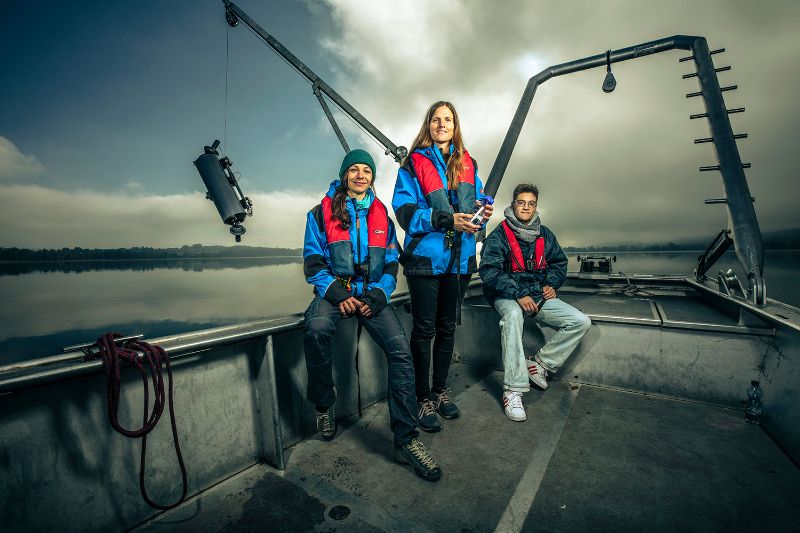Natural toxins: from the arsenal of a bacterium
During the warmer months, there are more and more headlines such as: “Are dogs still allowed to drink from the Greifensee?”, “Blue algae have also spread in the Lake Constance region” or “Dogs have died from poisoning: swimming ban in Lake Neuchâtel.” Often the lakes are then coloured blue-green or red. However, it is not by any means only algae that are responsible but also a large accumulation of so-called cyanobacteria, two billion-year-old organisms that can cause poisoning symptoms such as skin irritations or nausea in both humans and animals. A consequence of natural toxins (naturally present in the environment) that can produce cyanobacteria in warm waters. Elisabeth Janssen, who has a doctorate in environmental chemistry and works as the head of the “Environmental Chemistry of Biomolecules” research group at Eawag, is researching this phenomenon.
Ms Janssen, what are natural toxins?
Everything can be toxic. Only the dose makes the poison. Naturally toxic initially only means that a substance has not been synthesised in a laboratory, but that it involves substances that come from nature and can be toxic to aquatic organisms and also to humans.
Why are you interested in cyanobacteria of all things?
We are a water research institute, which is why we also deal with natural toxins in water. Cyanobacteria are fascinating because they produce a whole cocktail of interesting substances, some of which we know quite well and others not at all.
Are they all toxic?
That is often not so clear. I therefore like to call them bioactive. Each of these substances has a specific function. They are the biochemical arsenal which the bacterium needs to survive and uses to keep enemies in check or to gain access to nutrients. Approximately 2,000 molecules of the different types of cyanobacteria are known to exist, some of which can be potentially toxic. Research on this is still pretty much in its infancy.
Cyanobacteria first appeared in research literature at the end of 18th century when scientists assumed that poisoning symptoms in animals could be related to toxicity stemming from these bacteria. Since the 1960s, when eutrophication in lakes increased significantly, more intensive research has been conducted on this topic. After dialysis patients in Brazil had ingested a deadly liver toxin via cyanobacteria in fresh water in the 1990s, researchers improved the data available on the responsible toxin to such an extent that the first molecule of these bacteria was included in WHO guidelines. This is a prerequisite for setting health impairment limits. Three other cyanobacteria molecules are now on the list.
In total, only four molecules are classified as toxic by the WHO. Are cyanobacteria harmless after all?
No, they are not. It is just that it is difficult to establish a scientifically sound causal chain between the toxin responsible and a sick organism. Everyone who swims in a Swiss lake comes into contact with cyanobacteria. Whether a disease occurs depends on many different factors.
Namely?
If a dog dies, a post mortem examination is conducted, and samples are taken from the lake and examined. However, everything is very complex and fleeting. In most cases, it is almost impossible to determine the exact density of bacteria since a body of water never behaves statically. How much water did the dog actually drink and did he or she have any pre-existing illnesses? It is extremely challenging to determine this precisely based on both epidemiological and scientific data.
What exact approach do you take?
Most of the substances produced by cyanobacteria are not available for purchase, so we create laboratory cultures from bacteria that produce toxins, which are then isolated in the test tube. These act as a benchmark with which toxins from a body of water are compared. That is very challenging, even if it does not sound like it. For this to produce results, interdisciplinary expert opinions must be sought: for example, from ecologists, microbiologists, toxicologists or, like me, chemists. This is possible at Eawag.
What is the aim of this interdisciplinary scientific effort?
I want to develop reliable chemical analytical methods for measuring toxins originating from cyanobacteria. We need to know what is inside the lake and how long-lived the substances are. This has a big impact on many things: on toxicity and on the question as to how we must manage bodies of water or water purification.
What role do humans have in this?
Natural processes are strongly influenced by humans. The more we know about the toxins, the more we can also intervene in human-controlled interrelationships in order to better control cyanobacteria. In this respect, our team conducts basic research that can be applied in many areas.
